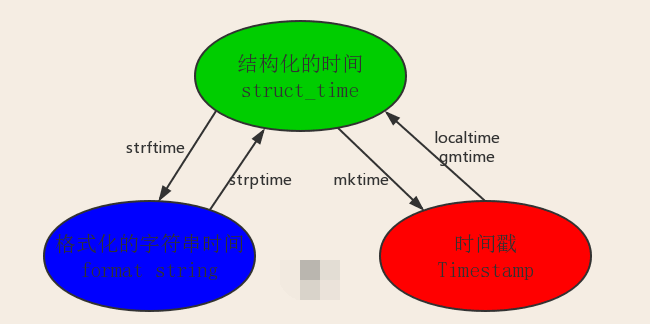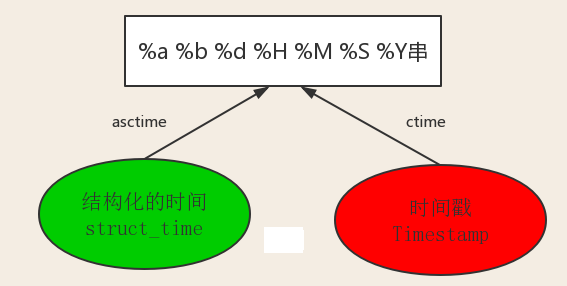Python--模塊之time、random、os、hashlib
阿新 • • 發佈:2017-06-22
常用 alex hex imp 分割 isa port 計算機 存在
一、 time模塊
表示時間我們通常用三種形式:
- 時間戳(timestamp):通常來說,時間戳表示的是從1970年1月1日00:00:00開始按秒計算的偏移量。我們運行“type(time.time())”,返回的是float類型。
- 格式化的時間字符串(Format String)
- 結構化的時間(struct_time):struct_time元組共有9個元素共九個元素:(年,月,日,時,分,秒,一年中第幾周,一年中第幾天,夏令時)
import time print(time.time()) #時間戳:1498025310.887425 print(time.strftime("%Y-%m-%d %X")) #格式化的時間字符串:2017-06-21 14:08:30 print(time.localtime()) #本地時區的struct_time print(time.gmtime()) #UTC時區的struct_time 結果: 1498025310.887425 2017-06-21 14:08:30 time.struct_time(tm_year=2017, tm_mon=6, tm_mday=21, tm_hour=14, tm_min=8, tm_sec=30, tm_wday=2, tm_yday=172, tm_isdst=0) time.struct_time(tm_year=2017, tm_mon=6, tm_mday=21, tm_hour=6, tm_min=8, tm_sec=30, tm_wday=2, tm_yday=172, tm_isdst=0)
三者的轉換關系:

計算機認識的時間只能是‘時間戳‘格式,而程序員可處理的或者說人類能看懂的時間有: ‘格式化的時間字符串‘,‘結構化的時間‘。
import time print(time.time()) print(time.localtime()) #將結構化的時間轉換為格式化的字符串時間 print(time.strftime("%Y-%m-%d %X", time.localtime())) #將結構化的時間轉換為時間戳print(time.mktime(time.localtime())) #將時間戳轉換為結構化的時間 print(time.localtime(1498025310)) #將格式化的字符串時間轉換為結構化的時間 print(time.strptime("2017-06-21 16:55:36", "%Y-%m-%d %X")) 結果: 1498035729.0793116 time.struct_time(tm_year=2017, tm_mon=6, tm_mday=21, tm_hour=17, tm_min=2, tm_sec=9, tm_wday=2, tm_yday=172, tm_isdst=0) 2017-06-21 17:02:09 1498035729.0 time.struct_time(tm_year=2017, tm_mon=6, tm_mday=21, tm_hour=14, tm_min=8, tm_sec=30, tm_wday=2, tm_yday=172, tm_isdst=0) time.struct_time(tm_year=2017, tm_mon=6, tm_mday=21, tm_hour=16, tm_min=55, tm_sec=36, tm_wday=2, tm_yday=172, tm_isdst=-1)

#將結構化的時間轉換為字符串時間 print(time.asctime(time.localtime())) print(time.asctime()) #如果沒有參數,將會將time.localtime()作為參數傳入。 print(‘我是分割線---------------‘) #將時間戳轉換為字符串時間 print(time.ctime(time.time())) print(time.ctime()) #如果沒有參數,將會將time.time()作為參數傳入。 結果: Wed Jun 21 22:19:16 2017 Wed Jun 21 22:19:16 2017 我是分割線--------------- Wed Jun 21 22:19:16 2017 Wed Jun 21 22:19:16 2017
二、 random模塊
import random print(random.random()) #(0,1)----float 大於0且小於1之間的小數 結果:0.3869734571949781 print(random.randint(1,3)) #[1,3] 大於等於1且小於等於3之間的整數 結果:3 print(random.randrange(1,3)) #[1,3) 大於等於1且小於3之間的整數 結果:1 print(random.choice([1,‘abc‘,[‘a‘,23,‘world‘]])) #1或者‘abc‘或者[‘a‘,23,‘world‘] 結果:[‘a‘, 23, ‘world‘] print(random.sample([1,‘abc‘,[‘a‘,23,‘world‘]],2)) #列表元素任意2個組合 結果:[[‘a‘, 23, ‘world‘], ‘abc‘] print(random.uniform(1,3)) #大於1小於3的小數 結果:2.164429956472153 l = [1,2,4,5,9] random.shuffle(l) print(l) #打亂l的順序,相當於"洗牌"[5, 2, 9, 4, 1]
生成隨機驗證碼實例:
import random def verify_code(): res = "" for i in range(5): res1 = random.randint(1,9) res2 = chr(random.randint(97,122)) res3 = chr(random.randint(65,90)) res4 = random.choice([str(res1),res2,res3]) res +=res4 return res print(verify_code()) 結果: IcglH
三 、os模塊
os模塊是與操作系統交互的一個接口
需要掌握的應用:
os.getcwd() 獲取當前工作目錄,即當前python腳本工作的目錄路徑 os.chdir("dirname") 改變當前腳本工作目錄;相當於shell下cd os.makedirs(‘dirname1/dirname2‘) 可生成多層遞歸目錄 os.removedirs(‘dirname1‘) 若目錄為空,則刪除,並遞歸到上一級目錄,如若也為空,則刪除,依此類推 os.mkdir(‘dirname‘) 生成單級目錄;相當於shell中mkdir dirname os.rmdir(‘dirname‘) 刪除單級空目錄,若目錄不為空則無法刪除,報錯;相當於shell中rmdir dirname os.listdir(‘dirname‘) 列出指定目錄下的所有文件和子目錄,包括隱藏文件,並以列表方式打印 os.remove() 刪除一個文件 os.rename("oldname","newname") 重命名文件/目錄 os.stat(‘path/filename‘) 獲取文件/目錄信息 os.path.abspath(path) 返回path規範化的絕對路徑 os.path.dirname(path) 返回path的目錄。其實就是os.path.split(path)的第一個元素 os.path.basename(path) 返回path最後的文件名。如何path以/或\結尾,那麽就會返回空值。即os.path.split(path)的第二個元素 os.path.exists(path) 如果path存在,返回True;如果path不存在,返回False os.path.join(path1[, path2[, ...]]) 將多個路徑組合後返回,第一個絕對路徑之前的參數將被忽略 os.path.getatime(path) 返回path所指向的文件或者目錄的最後存取時間 os.path.getmtime(path) 返回path所指向的文件或者目錄的最後修改時間
os.path.getctime(path) 回path所指向的文件或者目錄的創建時間 os.path.getsize(path) 返回path的大小
選擇性掌握的應用:
os.path.split(path) 將path分割成目錄和文件名二元組返回
os.path.isabs(path) 如果path是絕對路徑,返回True
os.path.isfile(path) 如果path是一個存在的文件,返回True。否則返回False
os.path.isdir(path) 如果path是一個存在的目錄,則返回True。否則返回False
示例:
import os print(os.getcwd()) os.chdir(r‘C:\Users\Administrator\PycharmProjects\untitled4‘) print(os.getcwd()) print(‘我是分割線--------‘) print(os.listdir(r‘C:\Users\Administrator\PycharmProjects\untitled4\a‘)) print(‘我是分割線--------‘) res = os.stat(r‘C:\Users\Administrator\PycharmProjects\untitled4\a\b\c\d‘) print(res) print(res.st_ctime) print(‘我是分割線--------‘) dirname,basename=os.path.split(r‘C:\Users\Administrator\PycharmProjects\untitled4\a\a.txt‘) print(dirname) print(basename) print(‘我是分割線--------‘) s1=r‘C:\Users\Administrator\PycharmProjects\untitled4\a\b\c‘ s2=r‘c.txt‘ res=os.path.join(s1,s2) print(res) 結果: C:\Users\Administrator\PycharmProjects\untitled C:\Users\Administrator\PycharmProjects\untitled4 我是分割線-------- [‘a.txt‘, ‘b‘] 我是分割線-------- os.stat_result(st_mode=16895, st_ino=7881299347966345, st_dev=1221946964, st_nlink=1, st_uid=0, st_gid=0, st_size=0, st_atime=1498052199, st_mtime=1498052199, st_ctime=1498052199) 1498052199.7336605 我是分割線-------- C:\Users\Administrator\PycharmProjects\untitled4\a a.txt 我是分割線-------- C:\Users\Administrator\PycharmProjects\untitled4\a\b\c\c.txt
四、hashlib模塊
hash:一種算法 ,3.x裏代替了md5模塊和sha模塊,主要提供 SHA1, SHA224, SHA256, SHA384, SHA512 ,MD5 算法
三個特點:
1.內容相同則hash運算結果相同,內容稍微改變則hash值則變
2.不可逆推
3.相同算法:無論校驗多長的數據,得到的哈希值長度固定。
import hashlib m=hashlib.md5()# m=hashlib.sha256() m.update(‘hello‘.encode(‘utf8‘)) print(m.hexdigest()) #5d41402abc4b2a76b9719d911017c592 m.update(‘alvin‘.encode(‘utf8‘)) print(m.hexdigest()) #92a7e713c30abbb0319fa07da2a5c4af m2=hashlib.md5() m2.update(‘helloalvin‘.encode(‘utf8‘)) print(m2.hexdigest()) #92a7e713c30abbb0319fa07da2a5c4af ‘‘‘ 註意:把一段很長的數據update多次,與一次update這段長數據,得到的結果一樣 但是update多次為校驗大文件提供了可能。 ‘‘‘
以上加密算法雖然依然非常厲害,但時候存在缺陷,即:通過撞庫可以反解。所以,有必要對加密算法中添加自定義key再來做加密。
import hashlib # ######## 256 ######## hash = hashlib.sha256(‘898oaFs09f‘.encode(‘utf8‘)) hash.update(‘alvin‘.encode(‘utf8‘)) print (hash.hexdigest())#e79e68f070cdedcfe63eaf1a2e92c83b4cfb1b5c6bc452d214c1b7e77cdfd1c7
實例:模擬撞庫破解密碼
import hashlib passwds=[ ‘alex3714‘, ‘alex1313‘, ‘alex94139413‘, ‘alex123456‘, ‘123456alex‘, ‘a123lex‘, ] def make_passwd_dic(passwds): dic={} for passwd in passwds: m=hashlib.md5() m.update(passwd.encode(‘utf-8‘)) dic[passwd]=m.hexdigest() return dic def break_code(cryptograph,passwd_dic): for k,v in passwd_dic.items(): if v == cryptograph: print(‘密碼是===>\033[46m%s\033[0m‘ %k) cryptograph=‘aee949757a2e698417463d47acac93df‘ break_code(cryptograph,make_passwd_dic(passwds)) 模擬撞庫破解密碼
python 還有一個 hmac 模塊,它內部對我們創建 key 和 內容 進行進一步的處理然後再加密:
1 import hmac 2 h = hmac.new(‘alvin‘.encode(‘utf8‘)) 3 h.update(‘hello‘.encode(‘utf8‘)) 4 print (h.hexdigest())#320df9832eab4c038b6c1d7ed73a5940
Python--模塊之time、random、os、hashlib
